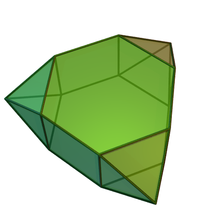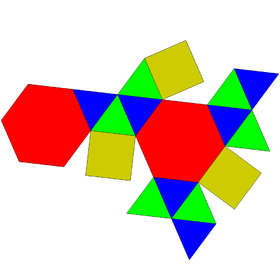Triaugmented hexagonal prism
57th Johnson solid
| Triaugmented hexagonal prism | |
|---|---|
 | |
| Type | Johnson J56 – J57 – J58 |
| Faces | 12 triangles 3 squares 2 hexagons |
| Edges | 30 |
| Vertices | 15 |
| Vertex configuration | 3(34) 12(32.4.6) |
| Symmetry group | D3h |
| Dual polyhedron | alternate order-4 truncated hexagonal bipyramid |
| Properties | convex |
| Net | |
 | |
In geometry, the triaugmented hexagonal prism is one of the Johnson solids (J57). As the name suggests, it can be constructed by triply augmenting a hexagonal prism by attaching square pyramids (J1) to three of its nonadjacent equatorial faces.
A Johnson solid is one of 92 strictly convex polyhedra that is composed of regular polygon faces but are not uniform polyhedra (that is, they are not Platonic solids, Archimedean solids, prisms, or antiprisms). They were named by Norman Johnson, who first listed these polyhedra in 1966.[1]
See also
- Hexagonal prism
References
- ^ Johnson, Norman W. (1966), "Convex polyhedra with regular faces", Canadian Journal of Mathematics, 18: 169–200, doi:10.4153/cjm-1966-021-8, MR 0185507, Zbl 0132.14603.
External links
- Weisstein, Eric W., "Triaugmented hexagonal prism" ("Johnson Solid") at MathWorld.
- v
- t
- e
- elongated triangular pyramid
- elongated square pyramid
- elongated pentagonal pyramid
- gyroelongated square pyramid
- gyroelongated pentagonal pyramid
- triangular bipyramid
- pentagonal bipyramid
- elongated triangular bipyramid
- elongated square bipyramid
- elongated pentagonal bipyramid
- gyroelongated square bipyramid
- elongated triangular cupola
- elongated square cupola
- elongated pentagonal cupola
- elongated pentagonal rotunda
- gyroelongated triangular cupola
- gyroelongated square cupola
- gyroelongated pentagonal cupola
- gyroelongated pentagonal rotunda
- gyrobifastigium
- triangular orthobicupola
- square orthobicupola
- square gyrobicupola
- pentagonal orthobicupola
- pentagonal gyrobicupola
- pentagonal orthocupolarotunda
- pentagonal gyrocupolarotunda
- pentagonal orthobirotunda
- elongated triangular orthobicupola
- elongated triangular gyrobicupola
- elongated square gyrobicupola
- elongated pentagonal orthobicupola
- elongated pentagonal gyrobicupola
- elongated pentagonal orthocupolarotunda
- elongated pentagonal gyrocupolarotunda
- elongated pentagonal orthobirotunda
- elongated pentagonal gyrobirotunda
- gyroelongated triangular bicupola
- gyroelongated square bicupola
- gyroelongated pentagonal bicupola
- gyroelongated pentagonal cupolarotunda
- gyroelongated pentagonal birotunda
- augmented truncated tetrahedron
- augmented truncated cube
- biaugmented truncated cube
- augmented truncated dodecahedron
- parabiaugmented truncated dodecahedron
- metabiaugmented truncated dodecahedron
- triaugmented truncated dodecahedron
- gyrate rhombicosidodecahedron
- parabigyrate rhombicosidodecahedron
- metabigyrate rhombicosidodecahedron
- trigyrate rhombicosidodecahedron
- diminished rhombicosidodecahedron
- paragyrate diminished rhombicosidodecahedron
- metagyrate diminished rhombicosidodecahedron
- bigyrate diminished rhombicosidodecahedron
- parabidiminished rhombicosidodecahedron
- metabidiminished rhombicosidodecahedron
- gyrate bidiminished rhombicosidodecahedron
- tridiminished rhombicosidodecahedron
(See also List of Johnson solids, a sortable table)
 | This polyhedron-related article is a stub. You can help Wikipedia by expanding it. |
- v
- t
- e











